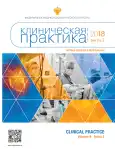Clinical observation of fatal bilateral spontaneous pneumothorax in wegener granulomatosis, which simulated lung cancer
- Authors: Khaydukova N.B.1, Khabarov Y.A.1, Stepanov V.A.1, Zvyezdkhina E.A.1, Ivanov Y.V.1
-
Affiliations:
- Federal Research Clinical Center of Specialized Medical Care and Medical Technologies of the FMBA of Russia
- Issue: Vol 9, No 2 (2018)
- Pages: 42-49
- Section: Original Study Articles
- URL: https://bakhtiniada.ru/clinpractice/article/view/10630
- DOI: https://doi.org/10.17816/clinpract09242-49
- ID: 10630
Cite item
Full Text
Abstract
We present a clinical observation of a 77 year-old patient admitted to the hospital with a sharp deterioration in the course of chronic obstructive pulmonary disease. The results of computed tomography of the chest read in favor of a newly detected malignant neoplasm of the upper lobe of the right lung with invasion into the mediastinum and secondary disseminations in the lower lobe of the left lung and liver. The performed fiber-optic bronchoscopy with a transbronchial lung biopsy did not verify the cancer diagnosis. The patient developed a bilateral spontaneous pneumothorax with the formation of bilateral bronchial-pleural fistulae with a massive air discharge through the pleural drainage. The presence of bilateral large bronchopleural fistulae did not allow a surgical intervention which required a separate intubation of the main bronchi. Minimally invasive techniques were ineffective. The patient died on the third day from the moment of the bilateral pneumothorax development due to severe respiratory failure. The autopsy established the diagnosis of Wegener’s granulomatosis affecting the lungs and kidneys.
Full Text
##article.viewOnOriginalSite##About the authors
N. B. Khaydukova
Federal Research Clinical Center of Specialized Medical Care and Medical Technologies of the FMBA of Russia
Author for correspondence.
Email: hirurgessa@mail.ru
врач торакальный хирург отделения хирургии
Russian Federation, MoscowYu. A. Khabarov
Federal Research Clinical Center of Specialized Medical Care and Medical Technologies of the FMBA of Russia
Email: dr.khabarov@mail.ru
к.м.н., врач торакальный хирург отделения хирургии
Russian Federation, MoscowV. A. Stepanov
Federal Research Clinical Center of Specialized Medical Care and Medical Technologies of the FMBA of Russia
Email: zvezdkina@yandex.ru
к.м.н., врач-рентгенолог отделения рентгенологии с кабинетами магнитно-резонансной томографии
Russian Federation, MoscowE. A. Zvyezdkhina
Federal Research Clinical Center of Specialized Medical Care and Medical Technologies of the FMBA of Russia
Email: zvezdkina@yandex.ru
врач патологоанатомического отделения
Russian Federation, MoscowYu. V. Ivanov
Federal Research Clinical Center of Specialized Medical Care and Medical Technologies of the FMBA of Russia
Email: ivanovkb83@yandex.ru
д.м.н., профессор, заслуженный врач РФ, заведующий отделением хирургии
Russian Federation, MoscowReferences
- Бекетова Т.В. Асимптомное течение поражения легких при гранулематозе с полиангиитом (Вегенера) // Научно-практическая ревматология. 2014. № 52 (1). С. 102–104.
- Болдарева Н.С., Злобина Т.И., Антипова О.В. и др. Поражение легких при гранулематозе Вегенера // Современные проблемы ревматологии. 2005. № 3. С. 19–122.
- Новиков П.И. Клиническая оценка вариантов течения и прогноза гранулематоза с полиангиитом (Вегенера): Автореф. дисс. … канд. мед. наук. М., 2015.
- Семенкова Е.Н., Кривошеев О.Г., Новиков П.И., Осипенко В.И. Поражение легких при гранулематозе Вегенера // Клиническая медицина. 2011. № 1. С. 10–13.
- Abdou N.I., Kullman G.J., Hoffman G.S. et al. Wegener’s granulomatosis: Survey of 701 patients in North America. Changes in outcome in the 1990s // The Journal of Rheumatology. 2002. Vol. 29. No. 2. P. 309–316.
- Belhassen-Garcia M., Velasco-Tirado V., Alvela-Suaréz L. et al. Spontaneous pneumothorax in Wegener’s granulomatosis: Case report and literature review // The Seminars in Arthritis and Rheumatism. 2011. Vol. 41. No. 3. P. 455–460.
- Bulbul Y., Ozlu T., Oztuna F. Wegener’s granulomatosis with parotid gland involvement and pneumothorax // Medical Principles and Practice. 2003. Vol. 12. P. 133–137.
- Epstein D.M., Gefter W.B., Miller W.T. et al. Spontaneous pneumothorax: An uncommon manifestation of Wegener granulomatosis // Radiology. 1980. Vol. 135. No. 2. P. 327–328. doi: 10.1148/radiology.135.2.7367621.
- Isabelle D., Khellaf M., Andre´ M. et al. Spontaneous pneumothorax in Wegener granulomatosis // CHEST. 2005. Vol. 128. P. 3074–3075.
- Jaspan T., Davison A.M., Walker W.C. Spontaneous pneumothorax in Wegener’s granulomatosis // Thorax. 1982. Vol. 37. P. 774–775.
- Kahraman Н., Inci М.F., Tokur M., Cetin G.Y. Spontaneous pneumothorax in a patient with granulomatosis with polyangiitis // BMJ Case Reports. 2012. Vol. 52. P. 37–41.
- Maguire R., Fauci A.S., Doppman J.L., Wolff S.M. Unusual radiographic features of Wegener’s granulomatosis // American Journal of Roentgenology. 1978. Vol. 130. No. 2. P. 233–238. doi: 10.2214/ajr.130.2.233.
- Michel J., Courthaliac C., Andre M. et al. Quid? Pneumothorax complicating Wegener disease with rupture of pleura of cavitary nodule // Journal de Radiologie. 2001. Vol. 82. No. 1. P. 73–75.
- Ogawa M., Azemoto R., Makino Y. et al. Pneumothorax in a patient with Wegener’s granulomatosis during treatment with immunosuppressive agents // Journal of Internal Medicine. 1991. Vol. 229. P. 189–192.
- Sezer I., Kocabas H., Melikoglu M.A. et al. Spontaneous pneumothorax in Wegener’s granulomatosis: A case report // Modern Rheumatology. 2008. Vol. 18. No. 1. P. 76–80. doi: 10.3109/s10165-007-0007-y.
- Shi X., Zhang Y., Lu Y. Risk factors and treatment of pneumothorax secondary to granulomatosis with polyangiitis: A clinical analysis of 25 cases // Journal of Cardiothoracic Surgery. 2018. Vol. 13. P. 7.
- Tarabishy A.B., Schulte M., Papaliodis G.N. et al. Wegener’s granulomatosis: Clinical manifestations, differential diagnosis, and management of ocular and systemic disease // Survey of Ophthalmology. 2010. Vol. 55. P. 429–440.
- Wolffenbuttel B.H., Weber R.F., Kho G.S. Pyopneumothorax: A rare complication of Wegener’s granulomatosis // European Journal of Respiratory Diseases. 1985. Vol. 67. P. 223–227.
- Zhiren Li X.B., Zhen J. The rare pulmonary manifestations of Wegener’s granulomatosis (report of 2 cases and literature review) // Chinese Journal of Practical Internal Medicine. 1992. No. 4. P. 216–217.
Supplementary files













